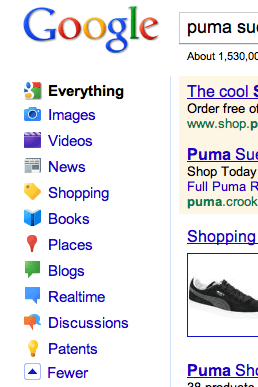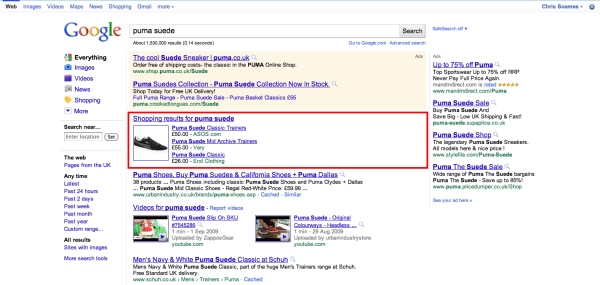Have you reviewed the importance of Google Blended results recently?

When considering traffic acquisition tactics and specifically Google as a channel to getting traffic it is easy to get caught up in optimizing web pages & “link building”.
Opportunities with Google extend much further through the blended or universal search. Looking down the left navigation bar "codenamed Jazz" on a search results page its easy to see that to reach people looking for different sorts of content in Google you should be:
- Creating news daily
- Writing blog posts
- Producing videos
- Publishing your product feed
- Active in forum and Q&A discussions
- Active in Facebook and Twitter for Realtime
Each of the areas above have their own section in Google and can often appear on results pages instead of webpages.
In this post I am focussing on the Google product service, which is shown in the search results as "Shopping", but you should also bear the other content types in mind when thinking of a traffic acquisition strategy. Ask how often do these blended results occur for the main types of customer search queries your targeting?
What is Google Product Search?
You will have more than likely seen this service while using a Google search results pages. Google Product Search is a service powered by retailers, allowing customers to search for specific products, filter, compare prices etc all within a results page before then selecting to click on a particular retailer. The beauty of Google Product search is it inserts a section within a search results page meaning its a great way to gain ‘rankings’ without the usual search techniques for web pages.  To decide which retailers to display Google mashes various pieces of data including website / product reviews, site performance (like speed) & where possible things like engagement & social score. Similar to the algorithm that powers the main results it is complex and yet get the basics right and you will do just fine.
To decide which retailers to display Google mashes various pieces of data including website / product reviews, site performance (like speed) & where possible things like engagement & social score. Similar to the algorithm that powers the main results it is complex and yet get the basics right and you will do just fine.
How do you get your products into Google Product Search?
A relatively straight forward process for most especially if you are using a popular ecommerce platform such as Magento or Shopify. The starting point for getting your products into Google is their Merchant Center. Once you have setup your merchant account you can then look at uploading your product feed by following these guidelines. Some of the key fields Google will require before accepting your products are:
- SKU
- Name
- Description
- Category (See Googles accepted categories here)
- Image URL
- Product URL
- Price
- Shipping Price
- In Stock
- Bar Code
- Payment types accepted
A quick tip - All product pages & images must be accessible to the Googlebot if the product is to be accepted.
Is it possible to track Google Product Search in Google Analytics?
Of course! Just use the Google URL builder to setup the tracking as required and make sure it is placed on all the product URL’s you supply to Google When using the data consider your KPI’s and ensure that most of them can relate to other channels so you can compare performance easily. I would ensure you look at:
- Overall traffic, sign ups & sales from Product Search
- Individual product - bounce rate vs conversion to sale rate
- Compare conversion rate to other channels such as SEO, PPC or Online Ads.
How to optimise Google Product Search?
There are some basic elements to all Google Product feeds that you should ensure are optimised. Consider how people will think when searching or researching your products, overlay data & keywords from the Google Keyword tool to help. Using this knowledge & insight ensure that the most relevant title & description are set for each product. The next area for ensuring your products display for relevant searches is to consider your pricing. Naturally pricing has wider ramifications (margins, brand perception etc) but we know through ecommerce sites people are familiar with sorting results by price (high & low) so getting this right will mean additional exposure. The single largest influencer (I believe) for doing well in Google Product is reviews based on the website & / or products. Ensuring you are constantly collecting reviews and making them available on your website is absolutely crucial to success.
Your website
When considering how to best optimise Google Product as a channel its easy to forget about the product pages on your website and how they perform. Consider running A/B tests to see if there are any missed opportunties with design / structure and try to ensure the stock on your website is reflected on Google Product. Having a popular product on Google that isn’t available to purchase will just irritate customers and create a bad brand experience.
Are there other similar services?
There are other services very similar to Google Products that offer another source of traffic, I have listed a few free & paid options below. Each has their own requirements as well as strengths and weaknesses. Free
- thefind
- Oodle
- ShopSavvy
- Bing (USA only at the moment)
Paid (on click or “action”)
- Kelkoo
- Shopzilla
- Shopping.com
- Caio
- Price Grabber
- Shop.com








